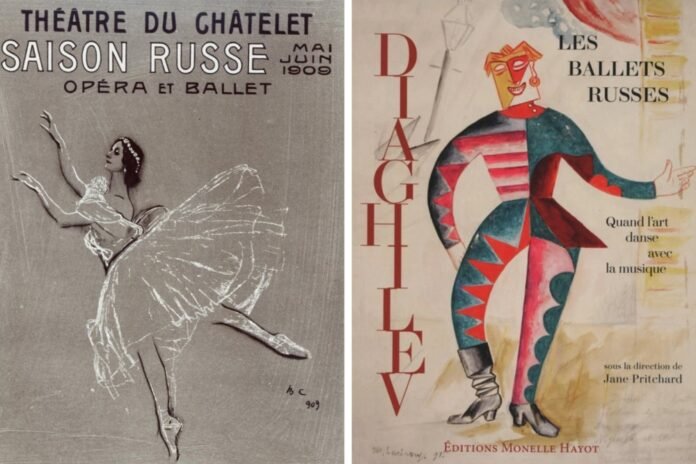On May 19, 1909, the first ballet performance of the Russian Seasons by the famous impresario Sergei Diaghilev took place in Paris.
Posters for the Russian ballet seasons in Paris.
Foreign tours of artists, called “Russian Seasons”, began in 1908 (two years earlier, an exhibition of Russian artists was held in Paris, and in 1907 – a series of “Russian Historical Concerts”).
In 1909, Sergei Diaghilev, philanthropist, businessman and ideologist of the “World of Art” society, brought Russian ballet to France for the first time. Since then, this phrase has served all over the world as a “sign of quality”, spiritual value and one of the symbols of Russia.
After the success of the exhibition and the concerts at the Grand Opera, where the opera “Boris Godunov” was performed (solo, among others, Chaliapin), Diaghilev wanted to present in Paris an anthology of opera classics: “Prince Igor ” by Borodin. , “Ruslan and Lyudmila” by Glinka, “The Pskovite” (“Ivan the Terrible”) by Rimsky-Korsakov, Judith from “Serov” and “Boris Godunov”. But they convinced him to also show Russian ballet.
The idea was supported by the dancer Matilda Kshesinskaya, close to the imperial court. The businessman was promised to allocate 25 thousand rubles to organize the tour – a very decent amount at that time. The artists were allowed to rehearse at the Hermitage.
Diaghilev conceived an idea that was revolutionary at the time: to create and present to the French a new type of ballet, created in “the unity of artistic concept and execution.” In practice, this meant attracting progressive artists (Alexandre Benois, Leon Bakst), composers (Nikolai Tcherepnin, a student of Rimsky-Korsakov), director Mikhail Fokine and the best ballet dancers: Anna Pavlova, Vera Fokina, Tamara Karsavina, Ida Rubinstein. , Vaslav Nijinsky and many others.
The artists were preparing for a performance in Paris, but suddenly everything changed. The government accepted the subsidy; Rehearsals at the Hermitage were suspended and the Mariinsky Theater was prohibited from providing scenery and costumes.
Behind the scenes, several reasons were given: in February 1909, Grand Duke Vladimir Alexandrovich (the younger brother of Alexander III), who favored Diaghilev, died. Matilda Kshesinskaya received an offer to play a small role in the ballet “Armida’s Pavilion”, although she was counting on more. In addition, the plans were hindered by the director of the imperial theaters, Vladimir Telyakovsky.
But Diaghilev had good friends. Prince Argutinsky-Dolgorukov, Countess Grefful and the businessman’s friend, pianist Misya Sert, who knew many creative personalities in Paris, helped him raise part of the funds. He helped rent and equip the French Chatelet Theatre.
Due to lack of funds, Diaghilev had to reduce his opera repertoire. As a result, what remained was “The Woman from Pskov”, in which Chaliapin played the role of Ivan the Terrible, and five ballets: “Armyda Pavilion”, “Polovtsian Dances”, “The Feast”, “Cleopatra” and “The Sylph.”
In April 1909, the Châtelet Theater began preparing for the arrival of Russian artists. Instead of stalls, boxes were installed and the stage was expanded. On May 19, French spectators saw the pantomime “The Pavilion of Armida”, “Polovtsian Dances” and “Feast”, and on June 2 they performed “The Sylph” and “Cleopatra”. Blue posters hanging around Paris depicted the ethereal Anna Pavlova, a drawing by Valentin Serov. This image became a symbol of the “Russian Seasons”.
Not only Pavlova shone on stage, but also other dancers: Karsavina, Nijinsky, Fokina, Rubinstein. The public was captivated by the decorations of Benois, Bakst and Nicholas Roerich: they gave rise to the fashion of the oriental style.
In Russia, the season was initially considered a “relatively successful undertaking,” but it was actually triumphant. The poet and playwright Jean Cocteau wrote: “A red curtain rises over the festivals that turned France upside down and carried the crowds into ecstasy following the chariot of Dionysus.”
The ballets that Diaghilev brought became, as they say today, a “brand” of Russia. “Europe seemed to have gone mad,” wrote contemporaries. Russian art overnight became the most fashionable in the world.
Subsequently, each “Russian season” left France: it was an international tour. The ballet was seen by spectators from 11 European countries, as well as the United States. This was the “advanced detachment” of Russian culture, which in 1911 was called “Diaghilev’s Russian Ballet.”

